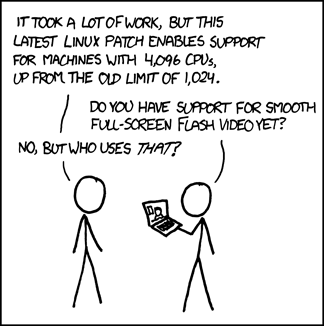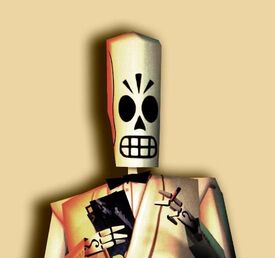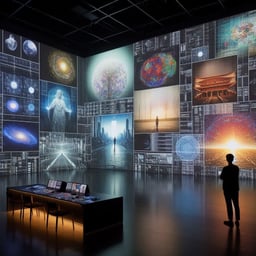Other features, like Thunderbolt, running displays over USB-C, the system’s built-in microphone, and the Touch ID fingerprint sensors, remain non-functional.
But at least the OpenGL benchmarks work 🫠
Writing drivers is hard, especially with limited or no hardware documentation.
It still has a long way to go, but Asahi Linux getting as far as it has this quickly is impressive enough.
Honestly mad respect to these Devs man. Gotta realise they’re doing this stuff for free and they’re not getting paid. If anyone hasn’t checked out the Asahi Linux blog, do give it a read, it has done fascinating deep dives into Apple’s hardware engineering.
Everything is reverse-engineered, and different people work on different stuff. It’s not like the resources devoted to OpenGL could be diverted to microphone support, that’s a completely different skill set.

Dude, Linux can’t make fingerprint readers work on regular machines… Nevermind hoping it to work from Apple’s hardware.
I had them working great in my Thinkpad X270, even you could authenticate or use it in the terminal with sudo. I miss my X270 man :/
Well, OpenGL had been deprecated on macOS for years before ARM Macs were even released. I personally was surprised that they even bothered to implement it.
It’s just a shame that these Macs will never be something I could buy when they become really cheap on the second hand market since you can’t upgrade the Ram or change the SSD.
It’s less that you can’t, more that it would be impractical to do it.
How would you do it?
Because once they can’t get MacOs updates, they’re gonna become really cheap and still feel nice compared to a lot of other computers.
It’s entirely possible - https://www.youtube.com/watch?v=Xrg7nPG6_UU&t=993s&pp=ygUIZG9zZHVkZTE%3D
But yeah, not currently practical.
I’m hoping that by the time my M2 Air is no longer supported, OpenCore will have cracked the M-series Macs. Failing that, Asahi ought to be damn near feature complete.
Oh gosh I only watched 3 minutes of it and it looks like hell😅
I guess my wife’s 2012 MacBook Pro (with Fedora) is the last apple computer I’ll use😇
Here is an alternative Piped link(s):
https://www.piped.video/watch?v=Xrg7nPG6_UU&t=993s&pp=ygUIZG9zZHVkZTE%3D
Piped is a privacy-respecting open-source alternative frontend to YouTube.
I’m open-source; check me out at GitHub.
You could probably change the ssd but the memory is on the SoC.
This is the best summary I could come up with:
The team has been steadily improving its open source, standards-conformant GPU driver for the M1 and M2 since releasing them in December 2022, and today, the team crossed an important symbolic milestone: The Asahi driver’s support for the OpenGL and OpenGL ES graphics have officially passed what Apple offers in macOS.
Developer Alyssa Rosenzweig wrote a detailed blog post that announced the new driver, which had to pass “over 100,000 tests” to be deemed officially conformant.
The team achieved this milestone despite the fact that Apple’s GPUs don’t support some features that would have made implementing these APIs more straightforward.
Rosenzweig’s blog post didn’t give any specific updates on Vulkan except to say that the team was “well on the road” to supporting it.
Though there are still things that don’t work, Fedora Asahi Remix is surprisingly polished and supports a lot of the hardware available in most M1 and M2 Macs—including the webcam, speakers, Wi-Fi and Bluetooth, and graphics acceleration.
Other features, like Thunderbolt, running displays over USB-C, the system’s built-in microphone, and the Touch ID fingerprint sensors, remain non-functional.
The original article contains 656 words, the summary contains 181 words. Saved 72%. I’m a bot and I’m open source!
I’d like to try Asahi on a VM, does anyone know if that can be done nowadays?
No if I am not mistaken, simply because the only thing that distinguishes asahi from mainline Linux is the hardware support. Through a VM you don’t have that weird hardware, so it just probably behaves as Linux on a VM
As far as I can tell, no.
However, I installed it on my M2 Air last weekend to give it a spin, decided it’s not ready enough for a Linux novice such as myself, and uninstalled it all pretty easily. It doesn’t mess with your macOS install at all. The only thing you need to be careful with is deleting the correct partitions.
I installed three times. The first, I didn’t give Asahi enough drive space to be all that useful. The second time I decided that I wanted to try KDE instead of Gnome. Those two uninstalls went without a hitch.
The third uninstall, however, I must have been careless, because I had to reinstall macOS through deleting a wrong partition. It wasn’t a huge issue for me, but it’s possible to do.
Mr Macintosh’ video on uninstalling it is spot on - https://www.youtube.com/watch?v=nMnWTq2H-N0&
Here is an alternative Piped link(s):
https://www.piped.video/watch?v=nMnWTq2H-N0&
Piped is a privacy-respecting open-source alternative frontend to YouTube.
I’m open-source; check me out at GitHub.
You need to find an image to install, but I think there shouldn’t be any technical issues beyond that
It’s just Fedora with GNOME or Plasma, install that on a VM and it’s the same thing.











